Frogs have been an important symbol in Chinese culture for centuries, with various meanings attached to them. In Chinese mythology, folklore, and literature, frogs are often portrayed as auspicious animals associated with good luck, prosperity, and fertility.
What are frogs and toads?
Greek for “without a tail,” the order Anura includes amphibians like frogs and toads. Both species are amphibians, meaning they can switch between aquatic and terrestrial habitats throughout their lives.
Despite their many shared characteristics, frogs and toads are not exactly the same. Frogs are amphibians that have the ability to both jump and swim quickly due to their long, powerful hind legs and moist, more supple skin. They have webbed feet and like to be near water, so you can usually find them in or near a body of water.
However, toads are adapted for walking rather than jumping, so they have rough, dry skin covered in warts and bumps and shorter legs. Although some species do prefer to live near water, they are more commonly encountered in drier environments like forests, deserts, and fields.
To communicate with one another, frogs use a wide range of calls and vocalizations and are generally more active during the day. In contrast, toads are primarily nocturnal and have fewer vocalizations in their repertoire.
Frogs and toads share the same carnivorous diet of insects, spiders, and worms. They are useful indicators of ecosystem health and aid in pest management.
difference between a frog and a toad
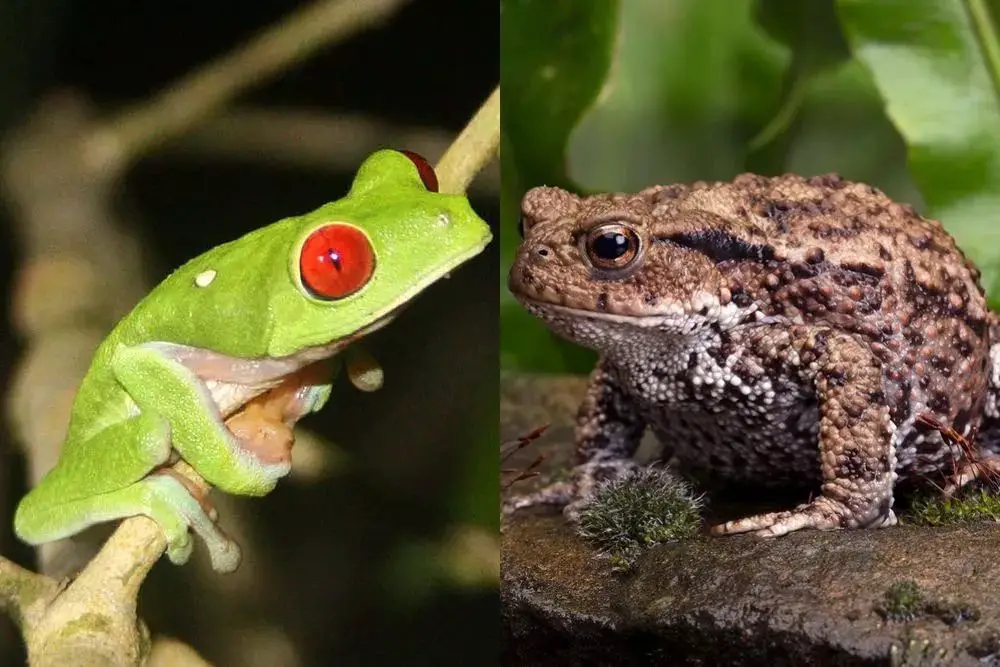
Frogs and toads are both amphibians that belong to the order Anura, which means “tailless” in Greek. While they share many similarities, there are some notable differences between the two.
- Physical appearance: Frogs typically have smooth, moist skin and long hind legs, which are adapted for jumping and swimming. They also have webbed feet and are often found near water sources. Toads, on the other hand, have dry, bumpy skin and shorter legs that are adapted for walking. They are often found in drier habitats like forests and fields.
- Habitat: As mentioned, frogs are commonly found near water sources like rivers, ponds, and lakes, while toads are typically found in drier habitats like forests, deserts, and fields.
- Behavior: Frogs tend to be more active during the day and have a wider variety of calls and vocalizations, which they use to communicate with other frogs. Toads, on the other hand, are generally more nocturnal and have a limited range of calls.
- Reproduction: Both frogs and toads lay their eggs in water, but the way they lay their eggs is different. Frogs usually lay their eggs in clusters, while toads lay their eggs in long strings.
- Diet: Both frogs and toads are carnivorous and feed on insects, spiders, and other small animals, but their feeding habits can differ. Frogs tend to hunt for their prey by sight and tend to be more active hunters, while toads are ambush predators that tend to wait for their prey to come to them.
What kind of frogs and toads are in China?
China is home to a diverse range of frogs and toads, with over 400 species found throughout the country. Some of the most notable species include:
- Chinese gliding frog (Rhacophorus dennysi): This frog is known for its ability to glide through the air using the webbing between its toes. It is found in the forests of southern and central China.
- Chinese giant salamander (Andrias davidianus): Although not a frog or toad, the Chinese giant salamander is an important amphibian species found in China. It is the largest amphibian in the world and is critically endangered due to habitat loss and overhunting.
- Asian common toad (Duttaphrynus melanostictus): This toad is found throughout much of Asia, including China. It is a large, warty toad that is often found in urban areas.
- Chinese spiny toad (Duttaphrynus stomaticus): This toad is found in the forests of southern China and has a distinctive spiny texture on its back.
- Chinese tree frog (Rhacophorus omeimontis): This frog is found in the forests of central and southern China and is known for its bright green coloration.
- Yunnan firebelly toad (Bombina lichuanensis): This toad is found in the mountains of southwestern China and has bright red or orange markings on its belly.
Frogs and toads in Chinese culture
There is a wide range of meanings associated with frogs and toads in traditional Chinese culture. They are featured in many works of art, from paintings to sculptures to literary works, because of the positive connotations associated with them.
frog in Chinese Feng Shui
Feng shui is a traditional Chinese method of interior design that aims to maximize the flow of beneficial qi (energy). The theory holds that the setting in which we live significantly influences our well-being, happiness, and success. The frog is a particularly significant symbol of good fortune and prosperity in feng shui, among many other animals.
As a symbol of prosperity and plenty, the frog plays an important role in Chinese culture. This is because “wa,” the Chinese word for frog, is phonetically similar to “cai,” the word for wealth. In feng shui, water represents wealth and plenty, and the frog shares this association.
Several different frog-related elements can be found in feng shui. Figurines and sculptures of frogs are frequently used in this way. Locations like the southeast corner and the entrance are common spots for these. It is recommended that the frog be displayed with its back to the door or wall, as doing so is thought to attract prosperity and success.
Feng Shui frog without coin: The three-legged toad, also known as the “money frog,” is a common frog-related feng shui statue. This particular frog statue is typically depicted with a coin in its mouth and resting atop a stack of currency. Because of its reputation for bringing prosperity and good fortune, the money frog is frequently displayed in the “wealth area” or near the main entrance of a home or business.
Frogs are used in feng shui in a number of different ways, including paintings, sculptures, and figurines. Having a painting or picture of a frog in your home, especially one that is set in a natural environment like a pond or river, is said to bring in the energy of prosperity and plenty.
Frogs can be used in feng shui, but it’s important to keep in mind a few key principles. Selecting a frog statue or painting that has personal meaning for you is one way to increase the room’s positive energy. In addition, keep the frog statue or painting free of dust and other debris that might obstruct the positive energy from flowing freely.
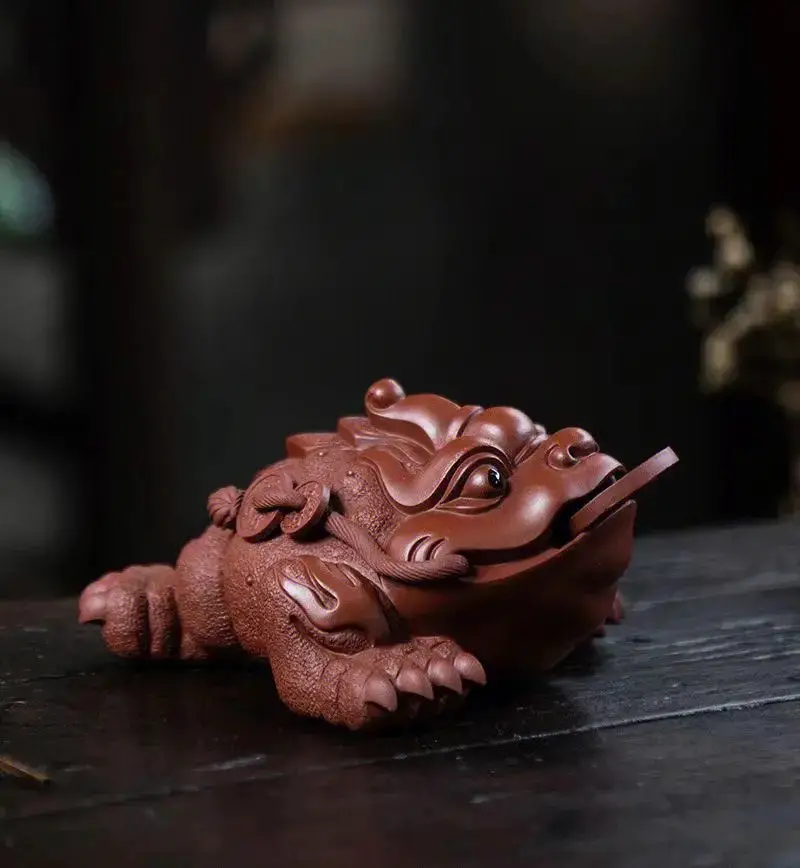
feng shui frog coin placement
Frog with coin in mouth meaning: In some cultures, the image of a frog with a coin in its mouth is associated with good luck, prosperity, and abundance. The frog is believed to be a symbol of transformation, fertility, and renewal. The coin in its mouth is thought to represent wealth and good fortune.
In Chinese culture, the frog with a coin in its mouth is known as “Chan Chu,” which means “wealth frog” or “money toad.” It is a popular Feng Shui symbol that is believed to bring wealth and abundance into the home or business. The frog is often depicted sitting on a pile of coins, with a red ribbon tied around its waist.
In Japanese culture, the frog is also considered a symbol of good luck and prosperity. The image of a frog with a coin in its mouth is known as “Zaogai,” which means “auspicious wealth.” The frog is often depicted with a scroll or bag of money in its mouth, as well as other auspicious symbols such as a peach or a crane.
Overall, the frog with a coin in its mouth is seen as a positive symbol of prosperity and good fortune in many cultures.
In Feng Shui, a frog with a coin in its mouth is often considered a symbol of wealth and prosperity. Here are some tips for placing a Feng Shui frog with a coin in your home or office:
- Placement: The frog with a coin should be placed in the wealth area of your home or office, which is typically in the far left corner of the space as you stand facing the room from the entrance.
- Direction: The frog should be facing inwards, towards the center of the room, as this is said to encourage wealth and abundance to flow into the space.
- Quantity: It is recommended to use one frog with a coin rather than multiple frogs, as this can create conflicting energies.
- Materials: The frog can be made of various materials, including metal, ceramic, or crystal. It is said that a metal frog is best for attracting wealth and abundance.
- Activation: To activate the Feng Shui frog with a coin, you can tap its back legs gently with a coin or ring, as this is said to activate its powers of wealth and abundance.
Overall, the placement of a Feng Shui frog with a coin is believed to help attract wealth and abundance into your home or office. However, it’s important to remember that Feng Shui is a complex and multifaceted practice, and the placement of a single object is just one small aspect of creating a harmonious and balanced living or working space.
feng shui money frog on elephant
In Feng Shui, the combination of a money frog and an elephant is a powerful symbol of prosperity, abundance, and good luck. The money frog is a popular Feng Shui symbol that represents wealth and good fortune, while the elephant is a revered animal in many cultures, symbolizing strength, stability, and wisdom.
When the money frog is placed on the back of an elephant, the energy of the two symbols is combined to create a potent Feng Shui cure for attracting wealth and abundance. Here are some tips for placing a Feng Shui money frog on an elephant:
Placement: The money frog on elephant should be placed in a prominent location in your home or office, such as the living room, office, or business reception area. The placement should be such that it is easily visible to anyone who enters the room, and it should be positioned in a way that it appears to be moving towards the interior of the space, as this is said to attract wealth and abundance into the space.
Direction: The elephant should be facing inward, towards the center of the room, while the money frog should be facing the entrance, as this is said to welcome wealth and prosperity into the space.
Materials: The elephant and the money frog can be made of various materials, including metal, ceramic, or crystal. It is recommended to choose high-quality materials to ensure that the energy of the objects is positive and strong.
Quantity: It is recommended to use only one money frog on elephant in your space, as too many similar objects can create conflicting energies.
Activation: To activate the Feng Shui money frog on elephant, you can place a coin or a piece of paper with your wealth intentions written on it in its mouth. You can also tap its back legs gently with a coin or a ring, as this is said to activate its powers of wealth and abundance.
In addition to the placement of the money frog on elephant, there are other Feng Shui principles that can help attract wealth and abundance into your space. These include decluttering and organizing your space, using colors and textures that promote wealth and prosperity, and incorporating plants and natural elements into your decor.
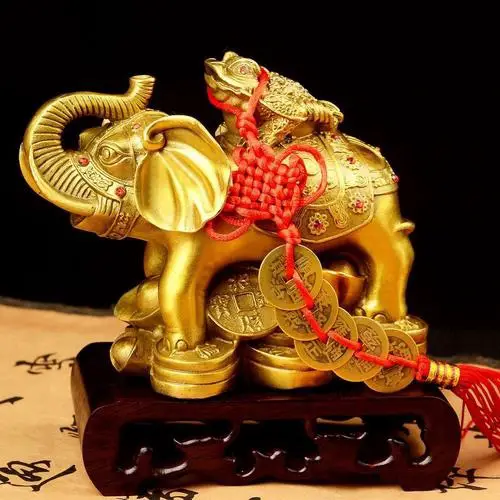
Toad in Chinese Mythology
Mythology1
It is said that Liu Hai was a simple-minded person who, under the guidance of Lü Dongbin, one of the Eight Immortals, obtained a shiny golden coin. With this coin, he eventually attracted the golden toad that had been lurking in a well and thus achieved a lifetime of happiness. This golden toad could continuously produce new coins, and the story of Liu Hai playing with the toad has been widely circulated among the people, with the meaning of attracting wealth and prosperity, leading to a happy and fulfilling life. People believe that obtaining a golden toad can bring wealth.
Therefore, we can still see today that many business people have a three-eyed Golden Toad on their desks, with one foot behind it, which originates from the story of Liu Hai playing with the Golden Toad. In ancient times, people generally believed that there were Chang’e and toads in the moon, and since there are toads in the moon, the moon is often referred to as the Toad Palace. Toads also symbolize longevity, and this tradition has a history spanning more than 2,000 years, dating back to the Spring and Autumn Periods.
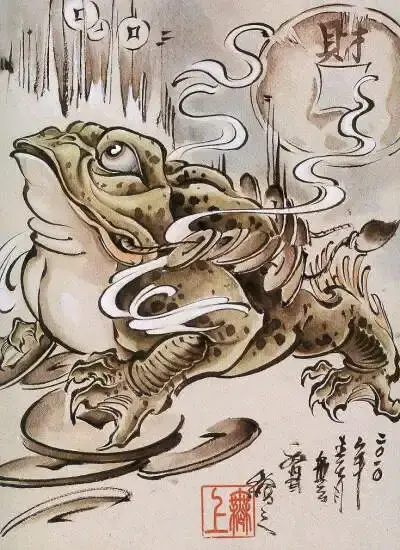
Mythology2
In the Han Dynasty, it was believed that Chang’e, after flying to the moon, turned into a toad. People initially wanted to connect the story of Chang’e with the toads on the moon, explaining the origin of the toads and the ending of the story of Chang’e and Hou Yi. However, over time, people found the story of a beautiful woman turning into a toad to be too negative, and the story of Chang’e became independent, resulting in the existence of both Chang’e and toads on the moon. With the development of Taoism, Chang’e emerged as the image of a celestial being in the moon palace, and the story of Chang’e turning into a toad gradually disappeared.
jin chan meaning
The Chinese mythological creature Jin Chan, also known as the “golden toad” or the “money toad,” is traditionally associated with wealth, good fortune, and success. The Jin Chan is typically depicted as a fat, three-legged frog or toad with a broad grin and golden skin. It’s often depicted either sitting on a stack of coins or with one in its mouth.
The Jin Chan has long been revered as a symbol of prosperity and good luck in China. Some say the Jin Chan was a mythical creature from the moon that was sent to Earth to aid humanity. The presence of a toad is thought to bring financial success and abundance to its owners, who believe the toad can sense luck and fortune.
In Feng Shui, an ancient Chinese practice that aims to balance the energy in a space to promote health, wealth, and happiness, the Jin Chan is widely used. As per the principles of Feng Shui, a Jin Cha placed near the entrance of a home or business, with its face turned inward, can bring about financial success. Having a coin in its mouth is also a common depiction of the Jin Chan, and it is thought that this is a sign of prosperity and good fortune for the house or business.
It is unknown for certain where the legend of Jin Chan first appeared, but it is widely assumed that it was in China during the Ming Dynasty (1368–1644). The fact that toads eat harmful insects and other pests may explain why they are symbolic of wealth and prosperity. Toads were once considered an indicator of a successful farm and were even used as a pest control method in some regions of China.
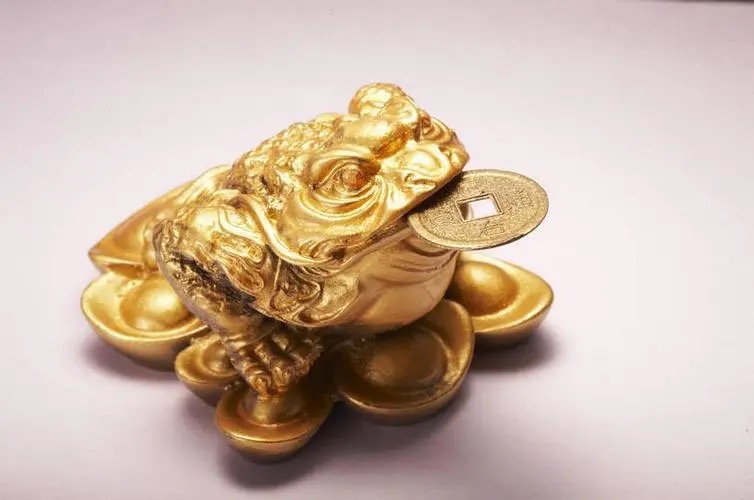
Frogs in Chinese Medicine
Frogs have been used in traditional Chinese medicine for thousands of years and are believed to have a wide range of therapeutic properties. In Chinese medicine, frogs are used in various forms, including dried skin, flesh, and oil. Here are some of the ways frogs are used in Chinese medicine:
- Treatment of skin disorders: The skin of certain species of frogs, such as the Asiatic toad, is believed to have anti-inflammatory and anti-tumor properties. Frog skin extracts are used in traditional Chinese medicine to treat skin disorders such as psoriasis and eczema.
- Relief of pain and inflammation: Frog oil, which is made by boiling the skin and flesh of frogs in sesame oil, is believed to have pain-relieving and anti-inflammatory properties. It is used in traditional Chinese medicine to treat arthritis, rheumatism, and other conditions that cause pain and inflammation.
- Boosting immunity: Some species of frogs, such as the giant ditch frog, are believed to have immune-boosting properties. Frog oil and extracts are used in traditional Chinese medicine to improve immunity and fight infections.
- Improving heart health: frog oil is believed to have a beneficial effect on the cardiovascular system. It is used in traditional Chinese medicine to treat conditions such as angina, high blood pressure, and atherosclerosis.
- Treating respiratory infections: Frog oil and extracts are believed to have antimicrobial properties and are used in traditional Chinese medicine to treat respiratory infections such as bronchitis and pneumonia.
- Enhancing sexual function: Frog oil is believed to have aphrodisiac properties and is used in traditional Chinese medicine to enhance sexual function and treat impotence.
- Improving vision: Frog oil is believed to have a beneficial effect on vision and is used in traditional Chinese medicine to treat eye disorders such as cataracts and glaucoma.
Despite the potential therapeutic benefits of frogs, their use in traditional Chinese medicine has been controversial. Some species of frogs are endangered due to overharvesting for use in traditional medicine, and there are concerns about the welfare of frogs that are kept in captivity for this purpose. In addition, the safety and efficacy of frog-based remedies have not been extensively studied, and there is limited scientific evidence to support their use.
In recent years, there has been a growing trend in China towards the use of synthetic and plant-based alternatives to animal-based traditional medicines. This is in part due to concerns about the sustainability of animal-based remedies as well as growing awareness of the potential risks associated with the use of animal products in medicine.
Why is the frog one of China’s five poisonous creatures?
In traditional Chinese medicine, there are five animals that are considered “poisonous creatures”: the snake, scorpion, centipede, spider, and toad. The toad, in this context, refers specifically to the Bufo bufo gargarizans, also known as the Asiatic toad or the Chinese toad. Here are some of the reasons why this toad is considered one of the “five poisonous creatures” in China:
- Toxic skin secretions: The skin of the Asiatic toad contains a powerful toxin called bufotoxin, which is secreted from the parotid glands located behind the eyes. Bufotoxin can cause symptoms such as nausea, vomiting, seizures, and even cardiac arrest if ingested in sufficient quantities.
- Use in warfare: Historically, the Chinese military used dried toad skin as a weapon of war. The skin was ground into a fine powder and mixed with other toxic substances to create a poisonous dust that could be blown into an enemy’s face.
- Use in traditional Chinese medicine: Despite its toxic properties, the Asiatic toad has been used in traditional Chinese medicine for thousands of years. The skin and secretions of the toad are believed to have anti-inflammatory and anti-tumor properties and are used to treat conditions such as cancer, inflammation, and skin disorders.
- Endangered status: Due to overharvesting for use in traditional Chinese medicine, the Asiatic toad is now considered an endangered species. Its status as one of the “five poisonous creatures” has contributed to its decline, as demand for toad-based remedies has led to unsustainable levels of harvesting.
- Cultural significance: In addition to its use in traditional medicine and warfare, the Asiatic toad has played a significant role in Chinese culture and folklore. It is often portrayed in art and literature as a symbol of transformation and renewal, and its image is associated with the lunar goddess Chang’e in Chinese mythology.
frog story
Chinese story: frog in the well
“The Frog in the Well” is a well-known Chinese fable that dates back to the Warring States period (475–221 BC). The story is often used as a metaphor for narrow-mindedness and the dangers of limiting one’s perspective.
The story goes like this: There was once a frog that lived in a well. The well was the frog’s entire world, and he believed that nothing existed beyond its walls. One day, a turtle came by, and the frog struck up a conversation. The frog boasted about how great his well was and how it was the only true home. The turtle, who had traveled far and wide, tried to explain to the frog that there was a whole world beyond the well, but the frog refused to believe him. He mocked the turtle for his absurd claim and refused to listen.
The moral of the story is that the frog, limited by his perspective, was unable to see the world beyond his well. In the same way, when we limit ourselves to a narrow point of view, we risk missing out on the vastness and complexity of the world around us. The story is often used as a cautionary tale, reminding us to keep an open mind and to be willing to listen to others, even when their perspective differs from our own.
“The Frog in the Well” has been referenced in a variety of contexts throughout Chinese history, from literature and philosophy to politics and diplomacy. In contemporary China, the story is often invoked in discussions about the need for open-mindedness and cultural exchange. It serves as a reminder that the world is a diverse and multifaceted place and that it is our responsibility to broaden our perspectives and engage with the richness and complexity of the world around us.

What is the moral of the frog in the well?
The lesson to be drawn from the fable known as “The Frog in the Well” is that thinking too narrowly can prevent one from seeing the big picture and leaving out important details. The story’s frog, who considered his well his entire world, actually lived in a well. He had never left the well, so he could not fathom or appreciate the world beyond his small sphere of experience. The frog didn’t care about the turtle’s view of the world’s size or how far it extended beyond the well, so the turtle gave up trying to convince the frog otherwise.
The moral of the fable is to be flexible in our thinking and willing to consider alternative points of view. Knowing that there is always something new to discover and being open to new information is crucial for expanding one’s horizons and gaining a more complete picture of the world.
The fable also stresses the value of self-awareness and humility. The frog was so arrogant in his own knowledge that he wouldn’t listen to the turtle, who had actually seen the world outside the well. We need to be humble enough to recognize our ignorance and eager enough to seek out the information and wisdom of others if we ever hope to gain a complete picture of the world.
The lesson to be drawn from “The Frog in the Well” is that we should seek knowledge and wisdom with an open mind, a sense of wonder, and a sense of modesty. Never settling for a narrow view of the world based on our own assumptions, we should be open to new information and ideas by actively seeking out the opinions of those with different backgrounds and experiences.
蟾宫折桂pluck cinnamon flowers in the Palace of the Moon
The idiom “蟾宫折桂” literally means “climbing and plucking the osmanthus flowers in the moon palace.” During the imperial examination in ancient China, it was used as a metaphor for passing the exam. It now means achieving great success or high honor, referring to passing the imperial examination, winning a championship in sports competitions, or obtaining a good ranking in various exams in social life. As early as the Warring States period, there was a Chinese folklore that there were toads in the moon. In early myths, there was a golden toad in the moon palace, also known as the three-legged golden toad. In Chinese mythology, there was a three-legged toad in the moon palace, and ancestors referred to the moon palace as the toad palace. Besides being called the “toad palace,” the moon palace is also known as the “palace of wide cold.” Because there is Wu Gang chopping down osmanthus trees on the moon, and the word “桂” has the same pronunciation as the word for “honor,” achieving high scores in exams is called “折桂.”
Chinese proverb–A toad wants to eat a swan
“The toad wants to eat swan meat” means having unrealistic and fanciful ideas, and it metaphorically describes someone who lacks self-awareness and desires something that is impossible to attain. The idiom is commonly used to describe a situation in which an unattractive man desires a beautiful woman, with the unattractive man being compared to a toad and the beautiful woman being compared to a swan.
conclusion
In conclusion, frogs are an important symbol in Chinese culture, representing good luck, prosperity, fertility, and transformation. Whether in mythology, literature, or everyday life, the frog continues to hold a special place in the hearts and minds of the Chinese people.